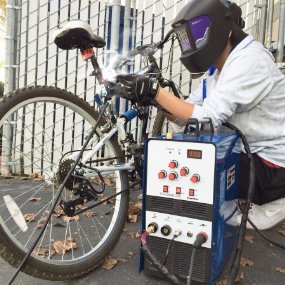Last updated on January 24th, 2019
 TIG Welding, also known as GTAW – Gas Tungsten Arc Welding, is often characterized as follows:
TIG Welding, also known as GTAW – Gas Tungsten Arc Welding, is often characterized as follows:
- Super clean (no smoke, no splatter)
- Join all kinds of metals (steel, aluminum, copper, brass, bronze, nickel, titanium, magnesium, etc)
- Great for delicate work and making jewelry
- Costly
- Slower than stick or MIG
- Harder to learn, especially for a beginner
With a TIG welding machine you can weld steel, aluminum, copper, brass, bronze, nickel, titanium, magnesium, and other exotic metals – it will do it all. And TIG offers a smaller welding area (compared to MIG or stick), which reduces distortion and heat.
A 110-volt TIG welding machine is great for making jewelry and delicate work.
Best TIG welding machines
TIG welding process compared to MIG (and others)
In TIG welding, a tungsten electrode is used to heat the metal you are welding and (usually Argon) gas protects your weld puddle from airborne contaminants.
More metals. You can use TIG welding to join more metals than any other welding method allows.
TIG is very clean. No smoke, sparks, fumes, spatter. No need to remove slag and spatter afterward.
TIG is the best method to use in places where you need a very precise weld. It is also preferable to use TIG over MIG where the appearance is critical (automotive and art, not so critical for household and farming needs).
TIG is more complicated for a beginner because it requires the use of both hands – you’ll need to hold the torch with one hand while feeding filler metal with the other hand. Also, TIG often requires a foot pedal or a finger-controlled remote control to set the voltage of the welding arc during the welding process.
Just as with MIG welding, a shielding gas (typically argon) is required.
When comparing to MIG or Stick welding, TIG is slower because you’ll need to apply the metal by hand and control the heat while welding. MIG welders come with a wire feeder which is faster.
Use one shielding gas (usually Argon) for all metals. Because Argon can be used to weld all kinds of metals it’s all you need.
Weld in different positions. Make flat and horizontal welds as well as vertical and overhead. TIG is good for welding in all positions.




























